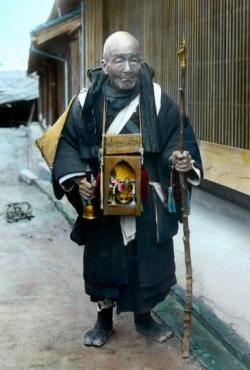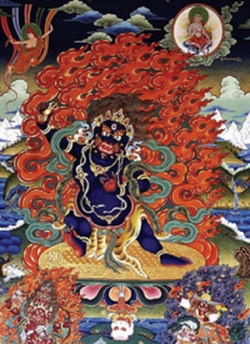The Samsaric Background
As in the case of all the Buddha's chief disciples, the Venerable Maha Kaccana's elevation to a position of pre-eminence in the Sangha was the flowering of a seed that had been planted long ago in the rolling cycles of samsara, the round of rebirths, and had been brought to gradual maturity over countless lives. The biographical sketch of Maha Kaccana[2] relates the story of the future disciple's original aspiration to a leading role in the Sangha. According to this account, the aspiration was formed 100,000 aeons in the past, during the Dispensation of the Buddha Padumuttara. At that time Kaccana had been reborn into a wealthy householder family. One day he went to hear the Buddha preach, and on that occasion, during his sermon, the Buddha appointed a certain bhikkhu as the foremost of those who can analyze in detail what had been stated by him in brief. The young householder was deeply impressed by the monk on whom this honor was bestowed, and the thought occurred to him: "Great indeed is that bhikkhu, in that the Teacher praises him so. I ought to attain such a position in the Dispensation of some future Buddha."
But to attain such a lofty status in the Dispensation, the generation of a wish is by no means sufficient. The aspiration must be supported by a base of meritorious deeds. Thus the young householder invited the Teacher to receive alms at his home, and for a full week he bestowed lavish offerings on the Buddha and his company of monks. At the week's end he prostrated himself at the Blessed One's feet and voiced his heart's desire: "Venerable sir, as the fruit of this offering I do not wish for any other achievement but this: that in the future, in the Dispensation of a Buddha, I might obtain the same position as the bhikkhu you appointed to that position last week."
Then Lord Padumuttara, looking into the future with his unimpeded knowledge of a Fully Enlightened One, saw that the youth's aspiration would be fulfilled. He told him: "Young man, in the future, after 100,000 aeons have elapsed, a Buddha named Gotama will arise. In his Dispensation you will be the foremost of those who can analyze in detail the meaning of what the Buddha has stated in brief."
The Apadana relates that in this same past life, Kaccana had built for the Buddha Padumuttara a stupa with a stone seat, which he had covered with gold; he had the stupa embellished with a jewelled parasol and an ornamental fan.[3] According to the above text, it was after he made this offering that the Lord Padumuttara predicted his future attainment to the position of a great disciple in the Dispensation of the Buddha Gotama. In this prediction the Blessed One also makes other prophecies concerning Kaccana's future sojourn in samsara, which from our temporal perspective would now constitute his past history. The Buddha foretold that as the fruit of his meritorious gifts, the householder would become a lord of the gods (devinda) for thirty aeons, exercising rulership over the gods. Having returned to the human world, he would become a world monarch (cakkavatti-raja) named Pabhassara, whose body would emit rays of light all around. He would spend his next to last existence in the Tusita heaven, and passing away from there, he would be reborn in a brahman family with the clan name Kaccana. In that life he would attain arahantship and be appointed a great disciple by the Buddha.
A later section of the Apadana gives a somewhat different account of Maha Kaccana's original aspiration to great discipleship.[4] In this version, at the time of the Buddha Padumuttara, the future disciple was an ascetic living in seclusion in the Himalayas. One day, while traveling through the sky by supernormal power, he passed over a populated area and saw the Victorious One down below. He descended, approached the Master to listen to the Dhamma, and heard him praise a certain bhikkhu (whose name was also Kaccana) as the chief among those who can elaborate on brief statements. Thereupon the ascetic, amazed by this unexpected encounter, went to the Himalayas, collected a bouquet of flowers, and, quickly returning to the assembly, presented them to the Buddha. At that point he formed the aspiration to become the chief expositor of the Dhamma in the Dispensation of some future Buddha. The Lord Padumuttara then prophesied that his aspiration would be fulfilled 100,000 aeons later when the Buddha Gotama arises in the world.
In this same series of verses Maha Kaccana states that as a result of his offering to the Buddha he never took rebirth thereafter in the nether world — in the hells, the animal realm, or the sphere of ghosts — but was always reborn either in the world of gods or in the human realm. Also, when he took rebirth as a human being, he was always reborn into the upper two social classes — among nobles or brahmans — and never into low-class families.
One important incident, which determined a particular feature of the great disciple's physical appearance during his final existence, took place during the Dispensation of the Buddha Kassapa, the immediate predecessor of Gotama in the lineage of Enlightened Ones. At the time of the Buddha Kassapa, Kaccana had taken rebirth in a family of Benares. After the Lord Kassapa's Parinibbana he offered a precious golden brick for the construction of a golden stupa for the Buddha. On presenting it he made the wish: "Whenever I am reborn, may my body always have a golden hue." As a result of this, when he was reborn during the time of our Buddha, his body was endowed with a beautiful golden hue, which deeply impressed those who beheld it.[5] In one case, which we will discuss below (see pp.13-15), this physical attribute of the elder led to a bizarre series of events.


